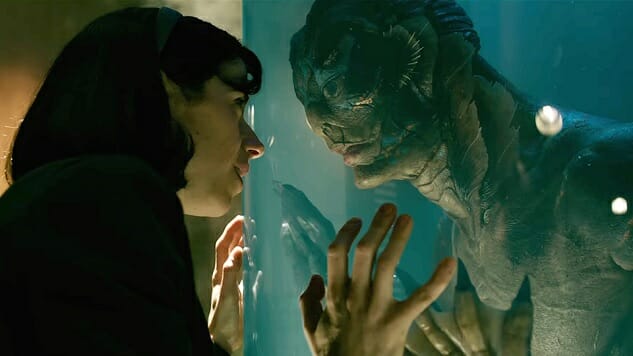
If there’s a waiting period filmmakers must abide before they can borrow from their own body of work, Guillermo del Toro either doesn’t know or doesn’t care. His new movie, The Shape of Water, an ageless story of true love between a human woman and a fish-man, references his filmography both at and below surface levels: It suggests a riff on Abe Sapien, the psychic ichthyoid sidekick in both Hellboy films (who is himself a riff on Creature from the Black Lagoon’s Gill-man, fed through a copyright strainer by his creator, Mike Mignola), but directly invokes the structure and fairy tale trappings of his 2006 breakout picture, Pan’s Labyrinth.
Del Toro has us set down in 1960s Baltimore, where Elisa Esposito (Sally Hawkins) works the janitorial night shift for the not-at-all-shady Occam Aerospace Research Center, scrubbing the floors clean of piss stains left behind by America’s greatest minds. She’s alone, mostly: She lives by herself in a timeworn loft where she has set her existence to a routine of boiling eggs, bathing, masturbating, making sandwiches, and indulging in television with her next door neighbor, Giles (Richard Jenkins), a commercial artist fallen on hard times. At the lab, she’s never without her coworker and friend, Zelda (Octavia Spencer). Giles and Zelda give Elisa a voice she quite literally lacks: She’s mute, and spends most of the film communicating with sign language.
Elisa’s clockwork days are disrupted by the arrival of the Asset (Doug Jones, the actor behind Abe Sapiens’ prosthetics), the aforementioned fish-man, carted into the lab in a pressurized tank. The Asset is in the custody of Colonel Strickland (Michael Shannon), at once the epitome of the del Toro villain and the average Shannon role: He’s abusive, violent, dictatorial to a fault, but mannered, the kind of bastard who thinks his dastardly bastard deeds are right and never thinks twice about his own morality. Elisa, ballsier than Strickland and basically every other man in the film, develops instant kinship with the creature. Like her, the Asset can’t speak. Like her, the Asset is achingly alone. She understands him, and as she introduces him to the joy of a good egg and a Benny Goodman song, so too does he understand her.
The success of their relationship hinges on performance as much as on direction. Del Toro cares about the well being of freaks and aberrations more than most people care about the well being of other actual people, and there you have step one. Step two rests on the shoulders of Hawkins and Jones, both capable, proven actors facing one of the most unique challenges of both their careers in The Shape of Water. She has a knack for playing spirited and undaunted types. (And, apparently, a talent for sign. If this whole “acting” thing falls through for her, she’d make a terrific interpreter.) He has a gift for showing us the humanity in the monstrous. Her pluck and cherubic longing pair beautifully with Jones’ physicality, such that the bond they dramatize onscreen stands out as one of the most genuinely romantic of the year. Contrasted against the movie’s three-pronged institutional threats their love story is one we’re happy to root for. Up with love! Down with authoritarianism!
Institutions are never safe in del Toro movies (and so it seems that neither are cats). But The Shape of Water harbors a subdued though searing anger toward institutions unmatched even by Hellboy. It takes a lot to make an American government agent a meaner heavy than the Nazis. Maybe it’s Shannon. Maybe it’s the general temperature of the moment we’re in, as taken by the film. The love at its center is so pure that it deserves to be carefree. Instead, it’s set upon from all sides. The U.S. brass wants the Asset for study. The Russians, having installed Dr. Hoffstetler (Michael Stuhlbarg) as a mole within Occam’s walls, want him dead so that the U.S. can’t study him. In between, there’s the side-eye Elisa gets from Giles and from Zelda, both bewildered by biological matters at first, though they’re quick to get over their own hangups. Love is strange, and so The Shape of Water is altogether strange and equally as sweet.
Visually, The Shape of Water screams dieselpunk, signifying Bioshock more than the brothers Grimm, but the film bears the indelible stamp of folkloric mythmaking all the same. Del Toro weaves together his influences so finely, so delicately, that the product of his handiwork feels entirely new: We recognize the pieces, and we cannot mistake the author, but cast in the warm, beryl glow of Dan Laustsen’s gorgeous cinematography, we feel as if we’re seeing them afresh. That’s the magic of the movies, and, more importantly, the magic of del Toro.
Director: Guillermo del Toro
Writer: Guillermo del Toro
Starring: Sally Hawkins, Doug Jones, Michael Shannon, Octavia Spencer, Ken Jenkins, Michael Stuhlbarg
Release Date: December 8, 2017
Boston-based pop culture critic Andy Crump has been writing about film and television online since 2009, and has been contributing to Paste since 2013. He also writes words for The Playlist, WBUR’s The ARTery, Slant Magazine, The Hollywood Reporter, Polygon, Thrillist, and Birth. Movies. Death., and is a member of the Online Film Critics Society and the Boston Online Film Critics Association. You can follow him on Twitter and find his collected writing at his personal blog. He is composed of roughly 65% craft beer.